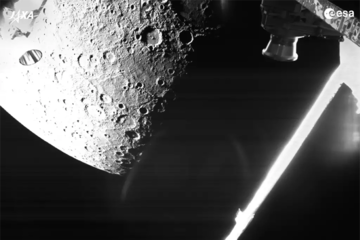All genres
101.
Journal Article
Electromagnetic noise and radio wave propagation below 100 kHz in the Jovian magnetosphere, 1. The equatorial region. Journal Geophysical Research 84, pp. 5181 - 5188 (1979)
102.
Journal Article
Energetic protons near the plasma sheet boundary. Nature 277, pp. 460 - 462 (1979)
103.
Journal Article
Are comets dirty snowballs or dust swarms? Nature 273, pp. 427 - 428 (1978)
104.
Journal Article
Quiet-time interplanetary cosmic ray anisotropies observed from Pioneer 10 and 11. Journal Geophysical Research 83, pp. 1633 - 1640 (1978)
105.
Journal Article
Anomalous acceleration of minor ions in the solar wind. Nature 274, pp. 350 - 351 (1978)
106.
Journal Article
The low energy charged particle (LECP) experiment on the Voyager spacecraft. Space Science Reviews 21, pp. 329 - 354 (1977)
107.
Journal Article
Discontinuous transitions in a current-carrying plasma. Astrophysics and Space Science 51, pp. 3 - 32 (1977)
108.
Journal Article
Comet exploration: Scientific objectives and mission strategy for a rendezvous with Encke. Progress in Astronautics and Aeronautics 50, pp. 209 - 236 (1977)
109.
Journal Article
Small scale auroral absorption events associated with substorms. Nature 267 (5611), pp. 502 - 504 (1977)
110.
Journal Article
Flow of mass and energy in the solar system. Physics of Solar Planetary Environments, Boulder/Colorado 1, pp. 270 - 275 (1976)
111.
Journal Article
Cosmic-ray gradients from Pioneer-10 and Pioneer-11. Astrophysical Journal 210, pp. 603 - 613 (1976)
112.
Journal Article
Helium isotopes in an aurora. Journal Geophysical Research 81, pp. 111 - 115 (1976)
113.
Journal Article
An analytic model illustrating the effects of rotation on a magnetosphere containing low-energy plasma. Journal Geophysical Research 81, pp. 3403 - 3406 (1976)
114.
Book
Plasma Astrophysics and Space Physics. Kluwer Academic Publishers, Dordrecht (1999), 772 pp.
115.
Book Chapter
Solar Wind. In: The Dynamic Sun, pp. 374 - 402 (Ed. Dwivedi, B.). Cambridge University Press, Cambridge (2003)
116.
Book Chapter
COSPAR during the period 1986-1994. In: 40 Years of COSPAR, pp. 131 - 137 (Eds. Haerendel, G.; Grzedzielski, S.; Cavallo, G.; Battrick, B.). ESA Publ. Div., Noordwijk (1998)
117.
Book Chapter
The outer heliosphere. In: From the Sun: Auroras, Magnetic Storms, Solar Flares, Cosmic Rays, pp. 143 - 152 (Eds. Suess, S. T.; Tsurutani, B. T.). American Geophysical Union, Washington D. C. (1998)
118.
Book Chapter
Acceleration of the high speed solar wind. In: Magnetodynamic Phenomena in the Solar Atmosphere-Prototypes of Stellar Magnetic Activity, pp. 115 - 122 (Eds. Uchida, Y.; Kosugi, T.; Hudson, H. S.). Kluwer, Dordrecht (1996)
119.
Book Chapter
Magnetospheres of the earth and planets. In: Encyclopedia of Applied Physics, pp. 187 - 205 (Ed. Trigg, G. L.). VCH Publ. Inc., New York (1994)
120.
Book Chapter
Scenario of solar wind interaction with Venus and Mars. In: Plasma Environments of Non-Magnetic Planets (Proc. 4th COSPAR Colloquium, Ann Arbor, U. S. A., 1992), pp. 207 - 216 (Ed. Gombosi, T. I.). Pergamon Press, Oxford (1993)











